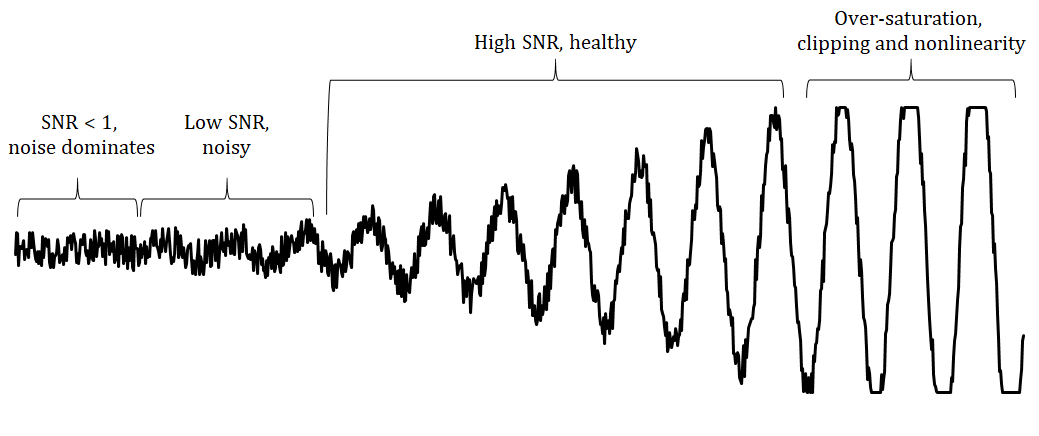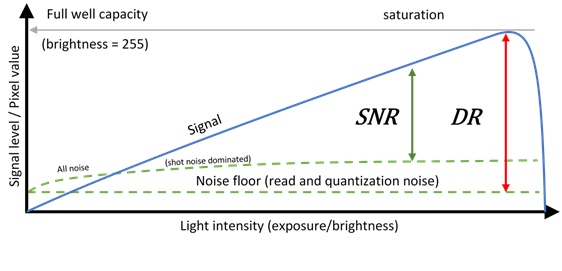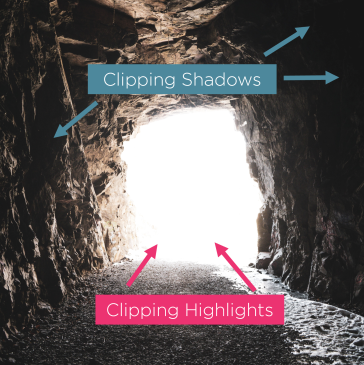Detectable Light Intensity in a Camera Capture
Introduction
카메라는 광자의 흐름을 정보가 포함된 이미지로 변환하기 때문에 우리의 눈과 매우 유사합니다. 카메라의 이미징 센서에는 픽셀 격자가 포함되어 있습니다. 각 픽셀은 판독 단계(노출이라고도 함) 동안 도달한 광자의 수를 계산하고 강도 점수를 출력합니다.
카메라의 다이내믹 레인지는 검정에서 흰색까지 측정 가능한 최소 및 최대 빛의 강도(Light intensity) 사이의 비율을 정의하며 사진에서 필수적인 속성입니다.

Light Intensity in Imaging Sensors
단일 이미지 획득을 위해 카메라 센서는 특정 범위 내에서 각 픽셀의 광도를 측정합니다. 일반적인 센서는 256에서 4096까지의 광도 레벨을 감지할 수 있으며, 이는 픽셀당 8비트에서 12비트의 데이터에 해당합니다.
The brightness of the pixel must be within the measurable range of the sensor, i.e., higher than 0 and lower than 255 for 8 bit images. All values outside the range are assigned the lowest or highest possible value. Therefore, if the brightness is 0 or 255, it becomes impossible to distinguish the real pixel intensity. For example, if the brightness is 255, the real value could be 255, 275, or 10000.
Signal and Noise in Light Measurement
예를 들어, 아래 그림을 살펴보겠습니다. 이 그림은 진폭이 증가하고 열 잡음이 결합된 사인파 모양의 전형적인 신호를 보여줍니다.

강도 측정 과정은 다음과 같이 진행됩니다.
잡음 플로어(왼쪽): 측정 가능한 최저 강도는 판독 및 양자화 잡음과 같은 잡음에 의해 제한됩니다. 감지되려면 빛의 강도가 이 잡음 플로어를 초과해야 합니다.
사용 가능한 신호 범위(중간): SNR이 낮고 높은 영역은 신호가 충분히 강해서 강도 수준을 정확하게 측정하고 구별할 수 있는 범위입니다.
채도(오른쪽): 빛의 강도가 너무 높으면 픽셀이 포화되어 잘림과 정보 손실이 발생합니다.
감지 가능한 가장 낮은 강도부터 측정 가능한 가장 높은 강도까지의 전체 범위를 센서의 동적 범위(DR)라고 합니다. 유효 신호 대 잡음비(SNR)는 신호 대 잡음비라고 합니다.
아래 그래프는 신호 레벨, 노이즈, 광도 간의 관계를 보여줍니다.

Clipping and High-Contrast Scenes
이미징 센서는 종종 장면의 완전한 동적 범위를 포착하지 못하여 클리핑이라는 광학 현상이 발생합니다. 클리핑은 특정 영역의 밝기가 센서가 표현할 수 있는 최소 및 최대 밝기 범위를 벗어나는 것을 말합니다. 이러한 디테일 손실은 매우 밝고 매우 어두운 장면이 모두 존재하는 고대비 장면에서 발생합니다.
Pixels with value 255 (for 8 bit images) are saturated (white) and pixels with values close to 0 (black) are in the noise floor.

Adjusting Exposure
A camera sensor’s upper and lower readout limits are roughly fixed in terms of photon count However, adjusting exposure changes the the number of photons entering the camera, hitting the pixel, and getting read.
노출 증가: 더 많은 광자가 픽셀에 도달하여 어두운 물체의 판독성이 향상됩니다.
노출 감소: 픽셀에 닿는 광자가 줄어들어 밝은 물체의 채도가 낮아집니다.
노출을 조정하면 센서가 최적의 범위에서 작동하여 해당 관심 영역에 대해 우수한 신호 대 잡음비(SNR)를 제공합니다. 이를 통해 장면의 밝은 영역과 어두운 영역 모두에서 균형 잡힌 밝기 수준을 얻을 수 있습니다.
Further reading
노출에 대해 자세히 알아보려면 다음 Introduction to Stops 를 읽어 보십시오.